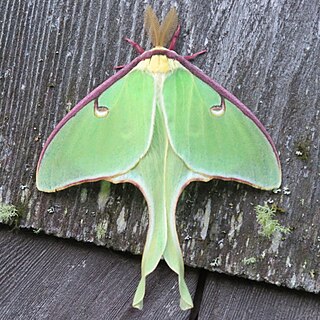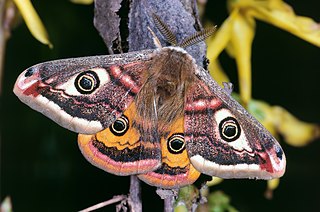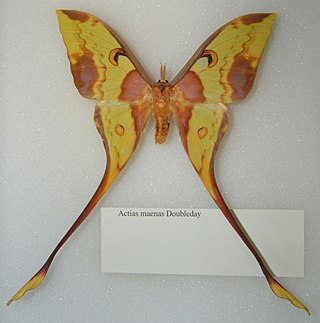
The luna moth, also called the American moon moth, is a Nearctic moth in the family Saturniidae, subfamily Saturniinae, a group commonly named the giant silk moths.

Saturniidae, members of which are commonly named the saturniids, is a family of Lepidoptera with an estimated 2,300 described species. The family contains some of the largest species of moths in the world. Notable members include the emperor moths, royal moths, and giant silk moths.

The Malaysian moon moth is a Saturniid in the subfamily Saturniinae from Indomalaya. The male is purplish-brown and yellow, while the larger female is overall light green.

Actias is a genus of Saturniid moths, which contains the Asian-American moon moths. Long tails on their hindwings are among their distinctive traits. Other moths with similar appearance are Copiopteryx, Argema and Eudaemonia.

The Sulawesi moon moth or Isis moon moth is a moth of the family Saturniidae first described by Léon Sonthonnax in 1899.

Actias ningpoana, the Chinese moon moth, is a species of moth in the family Saturniidae. The species was first described by father-and-son entomologists Cajetan and Rudolf Felder in 1862. It is quite large, and has long, curved, hindwing tails. There are many congeners across Asia; the Luna moth of eastern Canada and the United States is a close relative.

Actias sinensis, the golden moon moth, is a moth of the Family Saturniidae. It is found in China, Taiwan, Vietnam, Myanmar, India and Thailand. The species was first described by Francis Walker in 1855.

Actias neidhoederi is a species of moth belonging to the family Saturniidae. It is endemic to Taiwan.

Actias gnoma, also known as the Japanese moon moth, is a moth in the family Saturniidae The species was first described by Arthur Gardiner Butler in 1877. It is found in Japan and the Russian Far East.

Actias groenendaeli is a moth of the family Saturniidae first described by Roepke in 1954. It is found in Indonesia.

Actias angulocaudata is a moth in the family Saturniidae described by Stefan Naumann and Thierry Bouyer in 1998. It is found in China and Laos.
Actias australovietnama is a moth in the family Saturniidae. It is found in Vietnam.
Actias callandra, the Andaman moon moth, is a moth in the family Saturniidae. It is found in India.

Actias parasinensis, the western Chinese moon moth, is a moth in the family Saturniidae. It is found in Bhutan, India, Thailand, Laos and Vietnam.

Actias rhodopneuma, colloquially known as the pink spirit moth, is a moth in the family Saturniidae. It is found in China, Laos, Vietnam, Burma, Thailand and India. While there are not many reports about their host plants in the wild, in captivity they have been raised on Liquidambar, Cotinus, Prunus, Salix and Rhus. Usually it occupies the mountainous regions within its natural range and is found from 1000 m up to 4500 m in the mountains.
Actias arianeae is a moth in the family Saturniidae. It is found in China (Shaanxi).
Actias chrisbrechlinae is a moth in the family Saturniidae. It is found in China.
Actias uljanae is a moth in the family Saturniidae. It is found in China.
Actias winbrechlini is a moth in the family Saturniidae. It is found in China (Yunnan) and Burma.













